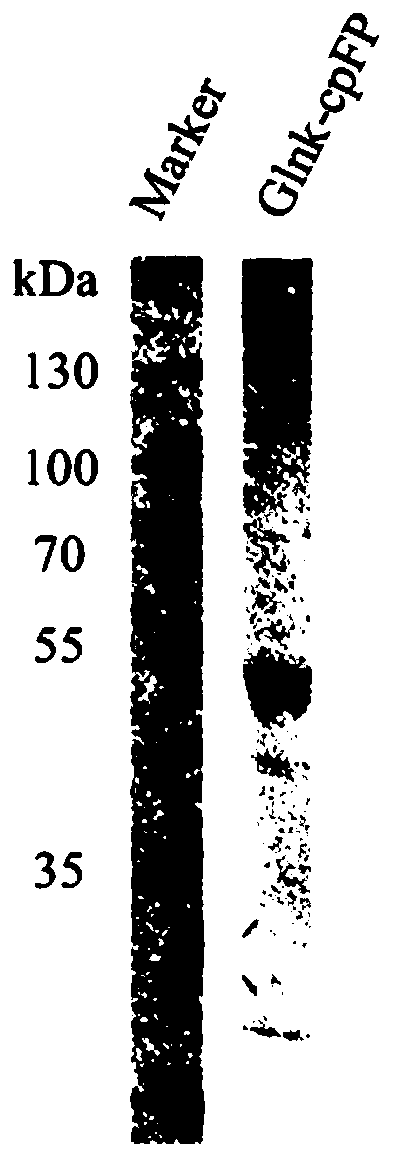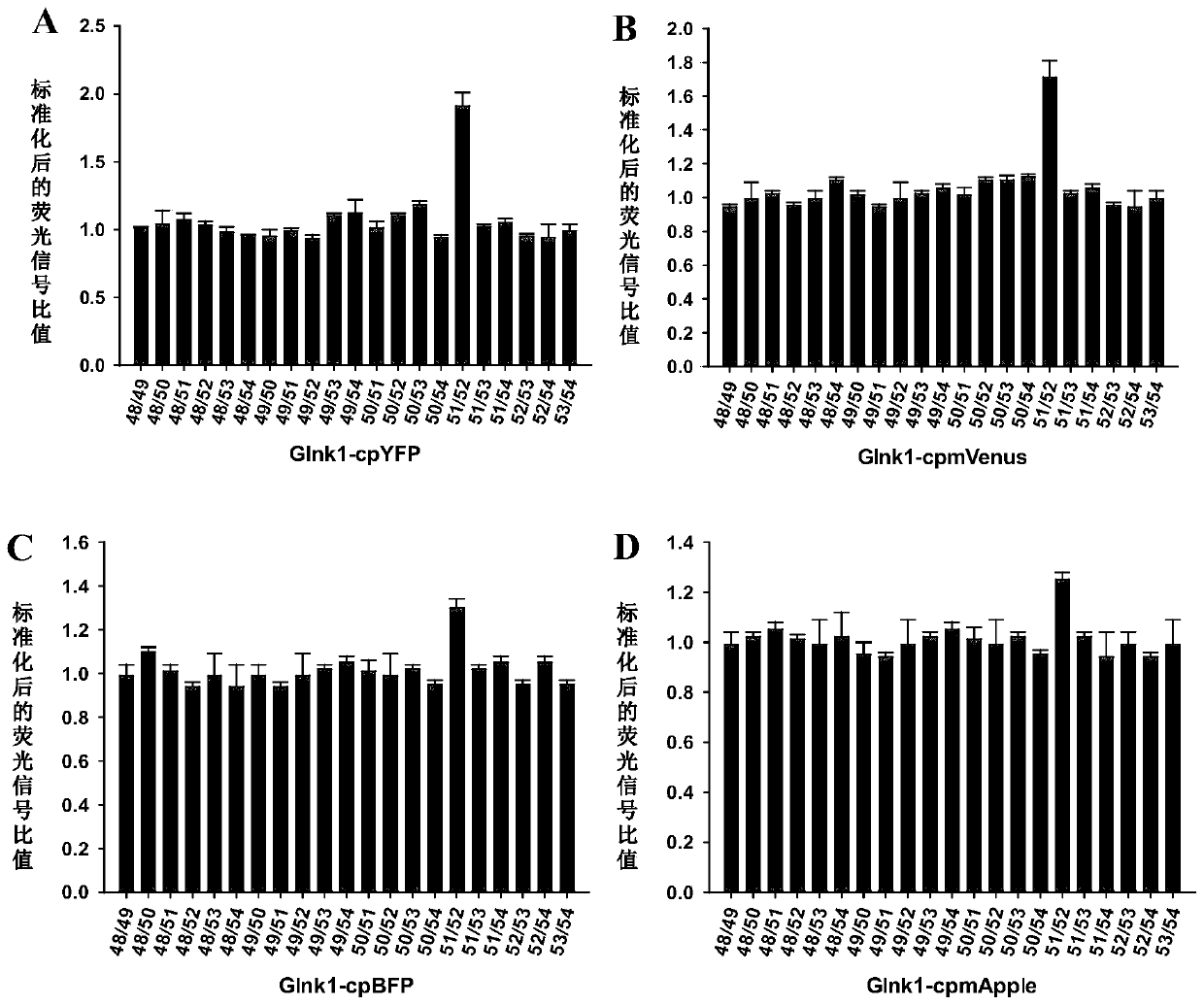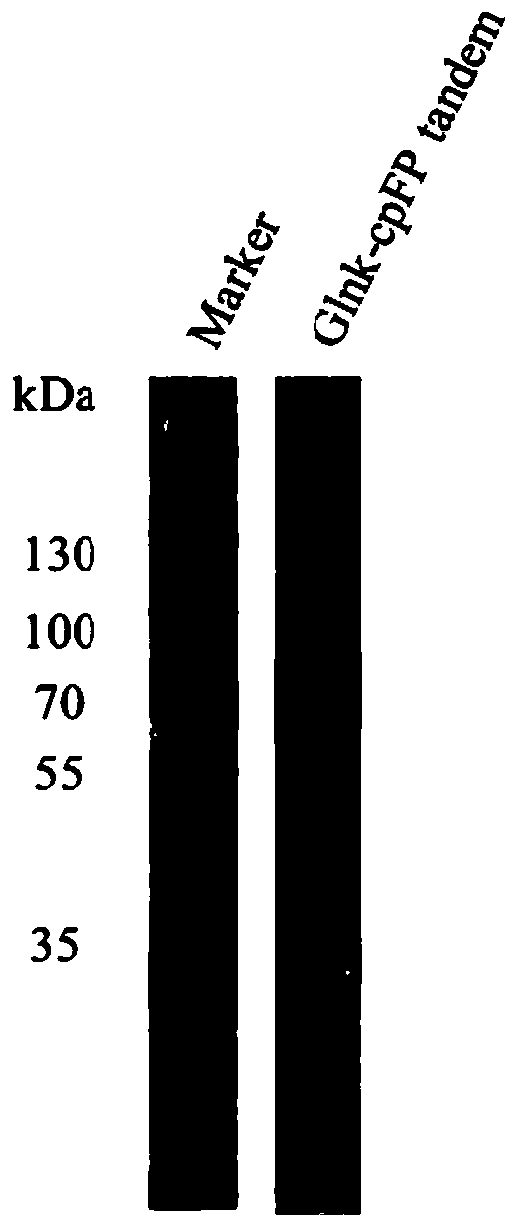Alpha-ketoglutaric acid optical probe and preparation method and application thereof
A technology of ketoglutaric acid and optical probes, applied in screening compounds or drugs, optical probes for detecting α-ketoglutarate, quantifying α-ketoglutarate, detection, the above-mentioned detection probes In the field of preparation, it can solve problems such as cumbersome operation steps, inability to use α-KG detection, and long time for sample processing
- Summary
- Abstract
- Description
- Claims
- Application Information
AI Technical Summary
Problems solved by technology
Method used
Image
Examples
Embodiment 1
[0258] pRSETb-Glnk1 plasmid construction
[0259] The Glnk1 gene was obtained through biosynthesis, and the gene was amplified by PCR. The PCR product of Glnk1 was recovered after gel electrophoresis, and digested with BamHI and HindIII; at the same time, corresponding double digestion was performed on the pRSETb vector. After ligation with T4 DNA ligase, the ligation product was transformed into Mach1, and the transformed Mach1 was spread on LB plates (ampicillin 100 μg / mL) and cultured at 37°C overnight. The growing Mach1 transformants were subjected to plasmid extraction and PCR identification. After the positive plasmid is correctly sequenced, the subsequent plasmid construction is carried out.
Embodiment 2
[0261] Plasmid construction and detection of different insertion sites of pRSETb-Glnk1-cpYFP, pRSETb-Glnk1-cpmVenus, pRSETb-Glnk1-cpBFP, pRSETb-Glnk1-cpmApple optical probe
[0262] In this example, we used pRSETb-Glnk1 as the base plasmid to select 48 / 49, 48 / 50, 48 / 51, 48 / 52, 48 / 53, 48 / 54, 49 / 50, 49 / 51 according to the Glnk1 crystal structure , 49 / 52, 49 / 53, 49 / 54, 50 / 51, 50 / 52, 50 / 53, 50 / 54, 51 / 52, 51 / 53, 51 / 54, 52 / 53, 52 / 54, 53 The / 54 site was inserted into cpYFP, cpmVenus, cpBFP, cpmApple.
[0263] The DNA fragments of cpYFP, cpmVenus, cpBPF, cpmApple were generated by PCR, and the DNA fragments were inactivated by adding phosphorus at the 5' end, and the pRSETb-Glnk1 linearized vector containing different breakage sites was amplified by reverse PCR , Ligate the linearized pRSETb-Glnk1 and the phosphorylated cpYFP, cpmVenus, cpBPF, cpmApple fragments at the 5' end under the action of PEG 4000 and T4 DNA ligase to generate recombinant plasmids, transform the ligat...
Embodiment 3
[0268] Plasmid construction and detection of pRSETb-Glnk1-cpYFP tandem, pRSETb-Glnk1-cpmVenus tandem, pRSETb-Glnk1-cpBFP tandem, pRSETb-Glnk1-cpmApple tandem optical probe insertion sites
[0269] In this example, we used the plasmids of pRSETb-Glnk1-cpYFP, pRSETb-Glnk1-cpmVenus, pRSETb-Glnk1-cpBFP, and pRSETb-Glnk1-cpmApple fluorescent protein in Example 2 as the basic plasmids, and then connected two plasmids A Glnk1 protein truncation mutant that deletes the T-loop region.
[0270] Using the pRSET-Glnk1 plasmid as the base plasmid, carry out truncation mutations (SEQ ID NO: 11 and SEQ ID NO: 7) on Glnk1 by reverse PCR and self-circularization ligation reaction. After the mutation is completed, two truncation mutations are generated by PCR After the Glnk1 DNA fragment. At the same time, pRSETb-Glnk1-cpYFP, pRSETb-Glnk1-cpmVenus, pRSETb-Glnk1-cpBFP, pRSETb-Glnk1-cpmApple linearized vectors containing different insertion sites were generated by inverse PCR amplification. ...
PUM
| Property | Measurement | Unit |
|---|---|---|
| molecular weight | aaaaa | aaaaa |
| molecular weight | aaaaa | aaaaa |
Abstract
Description
Claims
Application Information
 Login to View More
Login to View More - R&D
- Intellectual Property
- Life Sciences
- Materials
- Tech Scout
- Unparalleled Data Quality
- Higher Quality Content
- 60% Fewer Hallucinations
Browse by: Latest US Patents, China's latest patents, Technical Efficacy Thesaurus, Application Domain, Technology Topic, Popular Technical Reports.
© 2025 PatSnap. All rights reserved.Legal|Privacy policy|Modern Slavery Act Transparency Statement|Sitemap|About US| Contact US: help@patsnap.com



